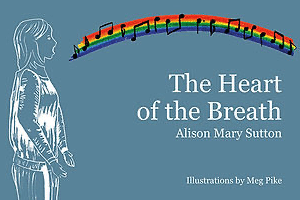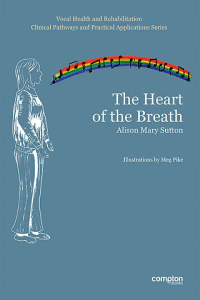The Heart of the Breath – Vocal Health and Rehabilitation

The Heart of the Breath – Vocal Health and Rehabilitation: Clinical Pathways and Practical Applications Series
Alison Mary Sutton
142 pps, Illustrations by Meg Pike, Compton Publishing, 2023
ISBN 978-1-909082-67-0

Available from Amazon: https://www.amazon.co.uk/Heart-Breath-Vocal-Health-Rehabilitation/dp/1909082678

The first two titles deal with complaints that present frequently in voice clinics, and which will also be familiar to many voice teachers, even those of us who aren’t rehabilitation specialists. As the stated aim of the series is to create a resource for teachers (also singers and other interested readers), it’s a promising start. A similar format is planned for every volume: one type of dysfunction or injury is presented in general terms, explained clearly and economically, with just enough scientific detail. A detailed account of one case study from Sutton’s studio follows, setting out her method for helping a singer overcome the issue in question.
The Heart of the Breath concerns Ethan, a young singer of contemporary commercial music (mainly hard rock), suffering from muscle tension dysphonia (MTD). Sutton identifies faulty breath technique as a major factor in his diagnosis and it’s his journey of relearning that provides the core of the book. She contends, as do many pedagogues, that the majority of vocal problems start with faulty breath management, which can lead to a host of unhelpful secondary behaviours. Even if a singer doesn’t experience any difficulties, breath, and its relationship to posture/alignment, is the bedrock of technique, so this is a logical jumping-off point for the series.
The meat of the book is prefaced by some background to Sutton’s work as a rehabilitation coach: her personal story as a singer, and how her wider life story informs, to a detailed level, her ethos and methodology, and aspirations for the series:“I want to look at ways in which singers can maintain the heart and health of their singing for as long as possible. Most importantly, my aim in working with any aspect of the voice is to encourage and regain the joy of singing…”.
She is clear (as should we all be): that every student and voice is unique, which must inform a teacher’s approach. Not only do voices differ, every student learns differently and takes different things from one’s teaching. Alongside this is her awareness of the integral relationship between voice, identity and emotional health. This means that our work as teachers is dynamic, always responding to the individual and their vocal and mental condition, every time we work with them. In Sutton’s case, this holistic way of approaching her work is based, at least in part, in her many years of practicing yoga, as is her belief in the primacy of breath to healthy voice function.
If personal stories interest you (they do me), this brief biographical detail is interesting on its own merits. Even if not, the relevance of this becomes apparent as the book progresses. Much of the book’s case study content is presented through online audio material, bringing the reader into the concentrated, intimate setting of the studio as a silent listener. The tone and pace of the work really reflect the character of the author and demonstrate the necessity of trust and rapport in a relationship of this sort.
The first not-quite half of the book is an overview of breathing for singing, including some observations of how inadequacy in this aspect of technique can adversely affect the voice’s function. The centrality of breath in yoga informs her conviction that “breath is everything!” It underpins all forms of voice work…”. It’s hugely to the author’s credit that she manages to write such a clear, concise overview of breath anatomy and function. The language is by no means simplistic; rather, it is to the point, and explains things in no more words than are necessary to achieve clarity and reader comprehension. I usually struggle somewhat with lengthy prose descriptions of anatomy/physiology, but found this extremely accessible. Sutton’s writing is some of the clearest I’ve read on the subject, especially in relation to the diaphragm and its interaction with the other primary respiratory muscles. Her explanation of each muscle group’s location and function is precise and uncomplicated, and the simple style of the accompanying anatomical illustrations reflect that. Any reader looking for a good primer in breath for singing will find this invaluable.
The rest of the book focuses on the case study. Sutton sets out her plan to help the singer overcome his MTD and return to a full schedule as a rock singer. The rationale for each stage is explained, the detail of the exercises she sets, and how Ethan responds. It’s not clear to what extent her protocol could be a template for others in similar situations, so perhaps the most useful takeaway is around the meticulousness of this work, and the extraordinary patience and attention of both parties to the process. That alone has certainly given me something to think about in my own practice. The exercises that I’m not already using will be valuable additions to my teaching toolkit, and I’ll be more mindful about appropriate deployment in future.
Huge credit is due to Ethan, a successful working singer, for allowing his story to be published and recordings of his sessions to be shared via YouTube. His motivation and conscientiousness is evident and he deserves a great career.
I have some editorial/production issues with the book, which I hope can be avoided in subsequent titles in the series. First, a design overhaul and the involvement of a good editor would make this an easier publication to use. Key pages use a light coloured type and/or tinted backgrounds, so accessibility concerns arise for the reader with less than perfect eyesight. Cross-referencing would be helpful when referring to previous pages or points, and paragraphs that depend on visual content would benefit from closer coupling with the illustrations. As it’s a pretty slim volume, flipping back and forth between pages is doable, but in general, I like a book’s layout to do as much work as it can. I noticed one missing reference, but again, suspect this is a publisher issue. Happily, there is an index (not guaranteed, even in professional-interest titles).
The book uses a mixture of photos and hand-drawn diagrams/charts. Meg Pike’s illustrations are a touch homespun looking, but are no less clear for being so. As an aside, artwork is an issue with a number of the best voice pedagogy books around. Some have excellent visuals – photography, diagrams and illustrations/cartoons – but it’s not unusual to see very amateurish drawings alongside high-quality writing.
The many exercises are described clearly, and supported with online audio and in some instances, video content. Some quibbles here: the link given to access this material isn’t direct (ie leads to an untrimmed pdf of a section of the book, where the link is repeated but still isn’t active), and for me, didn’t work at all. I eventually found the digital content by searching the author’s name on YouTube. Although Sutton’s delivery is perfectly paced and very clear, sound levels are very low. This is really noticeable in the soft-dynamic exercises, so, close to full volume is necessary. Prepare to be blasted by the first advert to play after the clip – it will be loud. I couldn’t hear the very first exercise, a demonstration of throat valve/Ujayi breathing at all. Navigating the channel within YouTube was a bit tiresome as there seemed to be no way of organising the more than 20 files, so there is much scrolling back and forth to find the one you want.
Despite those minor complaints, this is a really worthwhile book. Any mild inconvenience encountered with YouTube is more than compensated for by its clarity of purpose and lexical incisiveness. It’s clear that Sutton has read and collaborated widely, and her work is endorsed by a number of noted professional peers. If the rest of the series lives up to the standard set by this first title, Alison Sutton will have made a notable contribution to voice literature.
Review by Gerry McElearney who is a singing teacher and BVA Past President 2022-23

Last updated 29 September 2025
